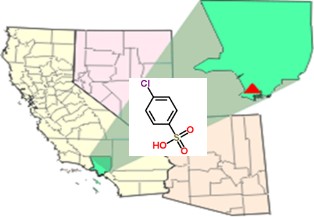Provisional Peer-Reviewed Toxicity Values (PPRTVs) Program Highlights
On this page:
Program Highlight: Set a Risk-Based Cleanup Level for Para-Chlorobenzene Sulfonic Acid (p-CBSA)
- Partner: California Environmental Protection Agency (CalEPA)
- Challenge: Set a risk-based cleanup level for p-CBSA
- Resource: Provisional Peer-Reviewed Toxicity Value (PPRTV) for p-CBSA
"When a chemical that had not been well-studied threatened an important drinking water aquifer in the L.A. Basin, scientists from ORD were important partners. They worked collaboratively with our state scientists to develop a risk assessment using the best available science." – CalEPA Secretary Matthew Rodriquez

The potential toxic effects of para-Chlorobenzene Sulfonic Acid (p-CBSA), a by-product of the production of the pesticide dichlorodiphenyltrichloroethane (DDT), present health concerns, particularly for drinking water contamination because the chemical is highly water soluble and mobile in aqueous environments. It has been identified in potential drinking water sources beneath and near sites in California, such as the former Montrose Chemical Corporation where DDT was manufactured from the 1950s to the early 1980s.
Because of high interest in evaluating the potential human health effects of p-CBSA, CalEPA and EPA ORD, in collaboration with Region 9 (Pacific Southwest), worked together in assembling existing study data leading to the development of a PPRTV assessment. Importantly, the information in PPRTV assessments can be used in combination with exposure metrics to characterize the public health risks of a given substance at a particular Superfund site. These risk characterizations can form the basis for risk-based decision making, regulatory activities and other risk management decisions designed to characterize and protect human health.
EPA ORD’s PPRTV assessment identified information sufficient for derivation of a provisional reference value that informs risk associated with oral p-CBSA exposures. The impact of this work will be realized in the facilitation of risk-based decision making and activities on sites contaminated with p-CBSA.
- Learn more about other EPA Research Support to the State of California
Program Highlight: Set a Risk-Based Cleanup Level for Styrene-Acrylonitrile (SAN) Trimer
- Partner: EPA Region 2
- Challenge: Set a risk-based cleanup level for Styrene-Acrylonitrile (SAN) Trimer
- Resource: Derive a Provisional Peer-Reviewed Toxicity Value (PPRTV) for SAN Trimer
“The NJDOH values our partnership with the EPA’s Office of Research and Development and the National Toxicological Program in an effort to understand the health impacts of community exposures to a previously unknown contaminant in Toms River.” – NJDOH State Epidemiologist/ Assistant Commissioner Christina Tan, MD, MPH

In 1996, New Jersey’s Department of Health found an increased incidence of childhood cancers in Toms River for the years 1979-1991. Following an analysis of various potential environmental causes of the elevated cancer rates, the presence of a group of unregulated, previously unknown contaminants was noted in the Reich Farm Superfund site’s groundwater plume. These contaminants, which are site-specific, were identified and are now referred to collectively as SAN Trimer. Due to citizen concerns about the toxicity of SAN Trimer, it was nominated to the National Toxicology Program (NTP) for toxicity testing by a member of Congress, and the final NTP report was publically released in 2012.
Due to high interest in the evaluation of potential health effects of SAN Trimer (particularly its cancer-causing potential) from the community of Toms River, the Potentially Responsible Party and Congressional and local authorities, a PPRTV assessment was developed by EPA ORD in response to an urgent request from Region 2 and was finalized in 2014. Importantly, the information in PPRTV assessments can be used in combination with exposure information to characterize the public health risks of a given substance at a particular Superfund site. These risk characterizations can form the basis for risk-based decision-making, regulatory activities and other risk management decisions designed to characterize and protect public health.
EPA ORD’s work allowed the development of a SAN Trimer cleanup level at the Reich Farm Superfund site. A detection limit was originally used as an interim cleanup level for SAN Trimer, but now, a scientifically based cleanup level derived from the PPRTV assessment developed by ORD can be used. Additionally, in 2015, a meeting was held in Toms River where NTP and ORD scientists presented their findings to the community.
